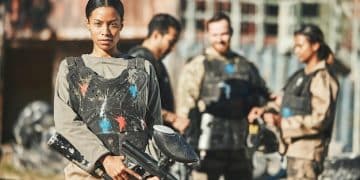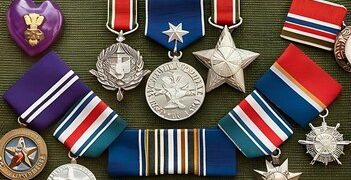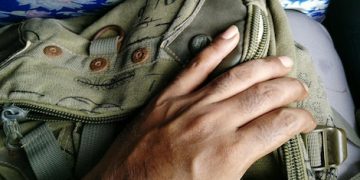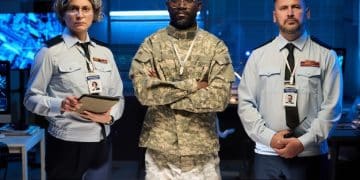Exploring Military Culture: Diversity Across Branches
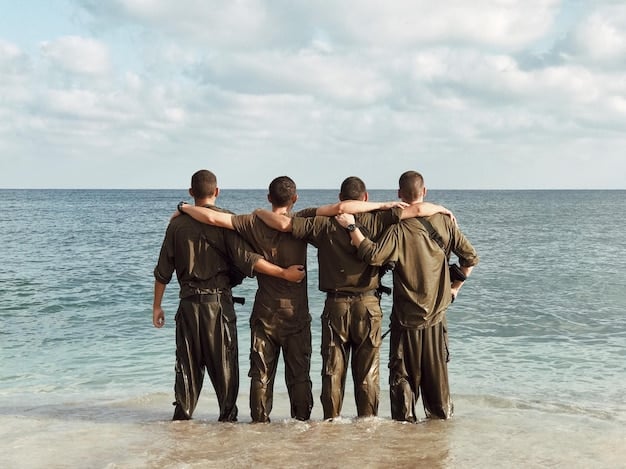
Exploring the diversity of military culture involves understanding the unique traditions, values, and social norms within different branches, reflecting each branch’s specific missions and historical contexts, ultimately shaping the identity and cohesion of its members.
The military is often seen as a monolithic entity, but **exploring the diversity of military culture: a look at different branches** reveals a rich tapestry of traditions, values, and social norms unique to each service. From the rigorous discipline of the Marine Corps to the technological focus of the Air Force, each branch cultivates its own distinct identity.
Understanding the Essence of Military Culture
Military culture is a blend of customs, traditions, and values that shape the behavior and mindset of service members. It’s more than just following orders; it’s about belonging to a community with a shared purpose and a deep sense of loyalty.
This culture is cultivated through rigorous training, shared experiences, and a commitment to core values such as honor, courage, and integrity. The specific manifestation of these values, however, can vary significantly between branches.
Core Values and Shared Experiences
At the heart of military culture are a set of core values that bind service members together. These values provide a moral compass and guide decision-making in challenging situations. Shared experiences, such as deployments and training exercises, further strengthen the bonds between individuals.
- Honor: Upholding the highest ethical standards and taking responsibility for one’s actions.
- Courage: Facing adversity and danger with bravery and determination.
- Commitment: Dedicating oneself to the mission and to one’s fellow service members.
- Integrity: Being honest, trustworthy, and reliable in all aspects of life.
The emphasis on these values creates a strong sense of camaraderie and mutual respect within the military community.
In essence, military culture isn’t just a set of rules, it’s a way of life deeply ingrained in those serving their country.
The United States Army: Tradition and Adaptability
The U.S. Army, the oldest and largest branch of the military, is known for its rich history and unwavering commitment to ground combat operations. Its culture emphasizes tradition, loyalty, and adaptability.
With a history dating back to the Continental Army, the Army’s culture is steeped in tradition. However, it also recognizes the need to adapt to evolving threats and technological advancements.
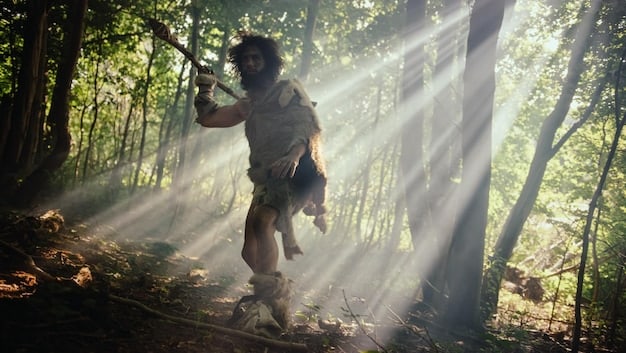
Emphasis on Loyalty and Teamwork
Loyalty to one’s unit and fellow soldiers is paramount in the Army. Teamwork is essential for success in combat, and soldiers are encouraged to rely on and support each other.
- The Soldier’s Creed: A set of principles that define the Army’s values and expectations for its soldiers.
- Unit Cohesion: The strong bonds between soldiers in a unit, fostering trust and mutual support.
- Respect for Tradition: Honoring the history and legacy of the Army through ceremonies and customs.
These elements contribute to a strong sense of identity and belonging within the Army community.
The Army’s culture strikes a balance between honoring tradition and embracing innovation, preparing its soldiers for the challenges of modern warfare.
The United States Navy: Seafaring Heritage and Technical Expertise
The U.S. Navy, responsible for maintaining maritime superiority, has a culture deeply rooted in seafaring traditions and a strong emphasis on technical expertise. The life aboard a ship fosters a unique sense of community.
Naval culture is influenced by centuries of maritime history. Sailors are expected to uphold time-honored customs and traditions, while also mastering complex technologies.
Discipline and Precision on the High Seas
Discipline and precision are essential on naval vessels, where even small errors can have significant consequences. Sailors are trained to perform their duties efficiently and effectively under pressure.
- Naval Customs: Saluting, addressing officers properly, and maintaining the cleanliness of the ship.
- Technical Proficiency: Mastering the operation and maintenance of advanced naval equipment.
- Adaptability to Isolation: Adjusting to long periods at sea and limited contact with the outside world.
These elements contribute to the Navy’s reputation for professionalism and excellence.
Life in the Navy develops within its members a blend of tradition and adaptability, readying them for the unpredictable nature of naval operations.
The United States Air Force: Innovation and Technological Advancement
The U.S. Air Force, the youngest branch of the military, is characterized by its focus on innovation, technological advancement, and air and space superiority. This is reflected in its progressive and forward-thinking culture.
The Air Force’s culture emphasizes cutting-edge technology and a commitment to continuous improvement. Airmen are encouraged to embrace new ideas and challenge the status quo.

A Culture of Excellence and Precision
Excellence and precision are hallmarks of the Air Force. From pilots executing complex maneuvers to maintenance crews ensuring the readiness of aircraft, airmen strive for perfection in all their endeavors.
- Air Force Core Values: Integrity First, Service Before Self, and Excellence In All We Do.
- Emphasis on Education: Encouraging airmen to pursue advanced degrees and technical certifications.
- Adaptability to Change: Embracing new technologies and adapting to evolving threats.
These elements contribute to the Air Force’s ability to maintain air and space superiority.
The Air Force fosters a culture that celebrates innovation and achievement, making it a driving force in military technology.
The United States Marine Corps: Esprit de Corps and Unwavering Discipline
The U.S. Marine Corps, known for its unwavering discipline, combat readiness, and esprit de corps, has a culture that emphasizes physical and mental toughness. It is an elite fighting force known worldwide.
Marine Corps culture is built on a foundation of rigorous training, shared hardship, and a deep sense of camaraderie. Every Marine is instilled with a strong sense of duty and a commitment to excellence.
Brotherhood Forged Through Adversity
The Marine Corps’ demanding training regimen and challenging deployments foster a strong sense of brotherhood among its members. Marines are known for their unwavering loyalty to each other.
- “Every Marine a Rifleman”: Regardless of their specialty, all Marines are trained in basic combat skills.
- The Marine Corps Hymn: A symbol of Marine Corps history and tradition.
- Emphasis on Physical Fitness: Maintaining a high level of physical readiness is essential for all Marines.
These elements contribute to the Marine Corps’ reputation for being a highly effective fighting force.
Whether ashore or abroad, the Marine Corps’ culture creates a strong bond of camaraderie between its members, preparing them for any challenge.
The United States Coast Guard: Service and Humanitarian Efforts
The U.S. Coast Guard, a unique branch with both military and law enforcement roles, has a culture that emphasizes service, humanitarian efforts, and maritime safety. Members are committed to protecting the nation’s waterways and saving lives.
The Coast Guard’s culture is shaped by its diverse missions, which range from enforcing maritime laws to conducting search and rescue operations. Coast Guardsmen are known for their professionalism and dedication to serving the public.
A Commitment to Maritime Safety and Security
The Coast Guard plays a vital role in ensuring the safety and security of U.S. waterways. Coast Guardsmen are trained to respond to a wide range of emergencies, from oil spills to maritime accidents.
- Search and Rescue: Saving lives at sea is a primary mission of the Coast Guard.
- Maritime Law Enforcement: Enforcing laws related to drug smuggling, illegal fishing, and other maritime crimes.
- Environmental Protection: Preventing and responding to oil spills and other environmental hazards.
These elements contribute to the Coast Guard’s reputation as a trusted and respected agency.
The Coast Guard provides a commitment to service, ensuring safety and protecting America’s coastlines and waterways.
| Key Aspect | Brief Description |
|---|---|
| 📜 Army Traditions | Rooted in history, valuing loyalty & adaptability. |
| 🌊 Navy Expertise | Seafaring heritage with precise technical skills. |
| 🚀 Air Force Innovation | Tech-driven, promoting excellence and progress. |
| 🛡️ Marine Corps Brotherhood | Discipline and esprit de corps forged through adversity. |
Frequently Asked Questions
▼
Military culture is a framework of values, beliefs, customs, and behavioral patterns that define the identity and operations of military organizations. It encompasses tradition, discipline, and a shared commitment to service and duty.
▼
Military culture varies because each branch has distinct missions, histories, and operational environments. These factors shape priorities, training methods, and the values emphasized, leading to diverse subcultures within the overall military framework.
▼
Values in military culture are instilled through rigorous training, mentorship, ceremonies, and the consistent reinforcement of core principles such as honor, courage, and commitment. These values guide conduct and decision-making.
▼
Technology significantly shapes military culture, especially in branches like the Air Force and Navy, where advanced systems require specialized expertise. The integration of new technologies fosters innovation and shifts operational strategies.
▼
The Marine Corps builds esprit de corps through demanding training exercises, shared hardships, and a deep sense of camaraderie and brotherhood among its members, emphasizing duty and the importance of every Marine.
Conclusion
In conclusion, **exploring the diversity of military culture: a look at different branches** reveals that while all branches share a commitment to service and national defense, their unique traditions, values, and operational focus create distinct cultures that shape the identity and experiences of their members.
